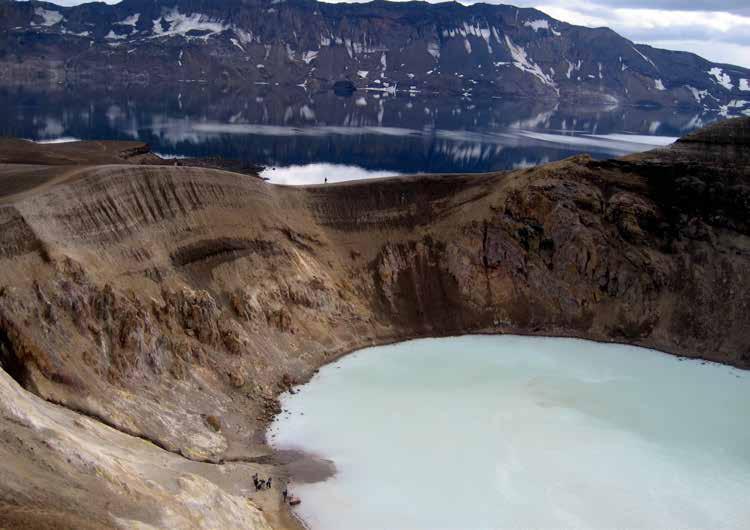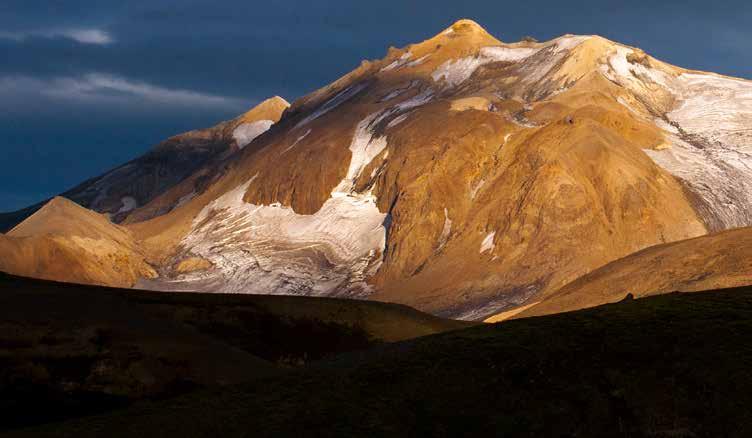
3 minute read
The Highlands in North East Iceland
An enchanting wilderness awaits those willing to take the challenge
Askja caldera and the Víti explosion crater Víti (Hell) was formed in an eruption in 1875.
During the past few decades, highland excursions have become increasingly popular. Walking enthusiasts quaff the fresh mountain air, while others prefer drives along unmade trails in jeeps and other rough terrain vehicles. A third group likes to combine highland jeep tours with hiking.
The highland scenery in Þingeyjarsýsla district is stark and diverse and offers visitors countless options.
Near and Far Highlands
The highlands may in fact be separated into two categories: the near highlands and the far highlands. The former term refers to the highland areas closest to populated districts. In this category, we find a large number of mountains that offer interesting trekking challenges. For example, the highland terrain west of Skjálfandi bay, jeep excursions to Flateyjardalur valley and walking tours from there into the Fjörður area, hiking terrain in Kinnarfjöll mountains, the Þeistareykir area, the mountains in the Mývatn area and the highland tract in the eastern part of Langanes point.
All these areas offer diverse landscapes and panoramic views of the surrounding scenery, an invigorating experience that inspires the traveller with a ‘joie de vivre’.
The far highlands signify the highland terrain north of Vatnajökull glacier. Some would call this ‘the real Icelandic highlands’ containing a large number of locations to enthral those who love the wilderness and its adventures.
The Highlands, in their stark beauty
These barren expanses offer countless routes of adventure. Some of these possibilities are described in more detail below.
Gæsavötn are two shallow lakes to the east of Tungnafellsjökull glacier. There is some vegetative cover around the lakes. The ruins of a stone and turf hut were found here in 1932; perhaps a testimony to outlaws or an ancient shelter for mountain travellers.
In olden times, a common route between north and south Iceland lay across the rocky desert of Sprengisandur where Kiðagil was a popular place of rest, a kind of mountain oasis. The memory of this resting place has been rendered immortal by the following lines from a well-known Icelandic ballad by poet Grímur Thomsen:
If Kiðagil I could descend I’d give my best steed to that end.
Dyngjufjöll mountains are located to the north of the Dyngjujökull glacier, which extends north from Vatnajökull. This is a barren mountain cluster encircling the 50 km2 Askja caldera. Subsidence in Askja’s south-east corner has formed a smaller caldera now filled by Öskjuvatn, one of Iceland’s deepest lakes, with a maximum depth of 220 metres. The Víti crater next to Öskjuvatn was formed in a huge explosive volcanic eruption in 1875. The warm water in

Summer evening by Lúdentsborgir. Lúdentsborgir are part of a crater row in the Mývatn area.

Herðubreið mountain has been called the queen of Icelandic mountains. the crater is suitable for bathing and is popular with visitors.

Queen of the Mountains
Ódáðahraun is Iceland’s most extensive lava field, a practically continuous desert from the Vatnajökull glacier northwards to the mountains in the Mývatn region. The most renowned of those is Herðubreið, a table mountain 1682 metres in height, long referred to as ‘the Queen of Icelandic mountains’ and recently elected Iceland’s National Mountain by popular vote.
Approximately 5 km north of the mountain are Herðubreiðarlindir springs, a green oasis in stark contrast to the bleak surrounding desert. Conspicuous among the lush Herðubreiðarlindir flora are clusters of garden angelica, several willow varieties and colourful aggregations of arctic river beauty. Herðubreið and its surrounding areas were declared a nature reserve in 1974.
Kverkfjöll mountains are a huge mountain range at the northern extremity of Vatnajökull glacier. The region is characterised by alternations of ice sheets and clusters of natural hot springs, with the most prominent, Hveradalur, being the among the greatest high temperature geothermal areas in Iceland. In summer, regular tours are operated to the Kverkfjöll region from Akureyri, Húsavík and the Mývatn District.










